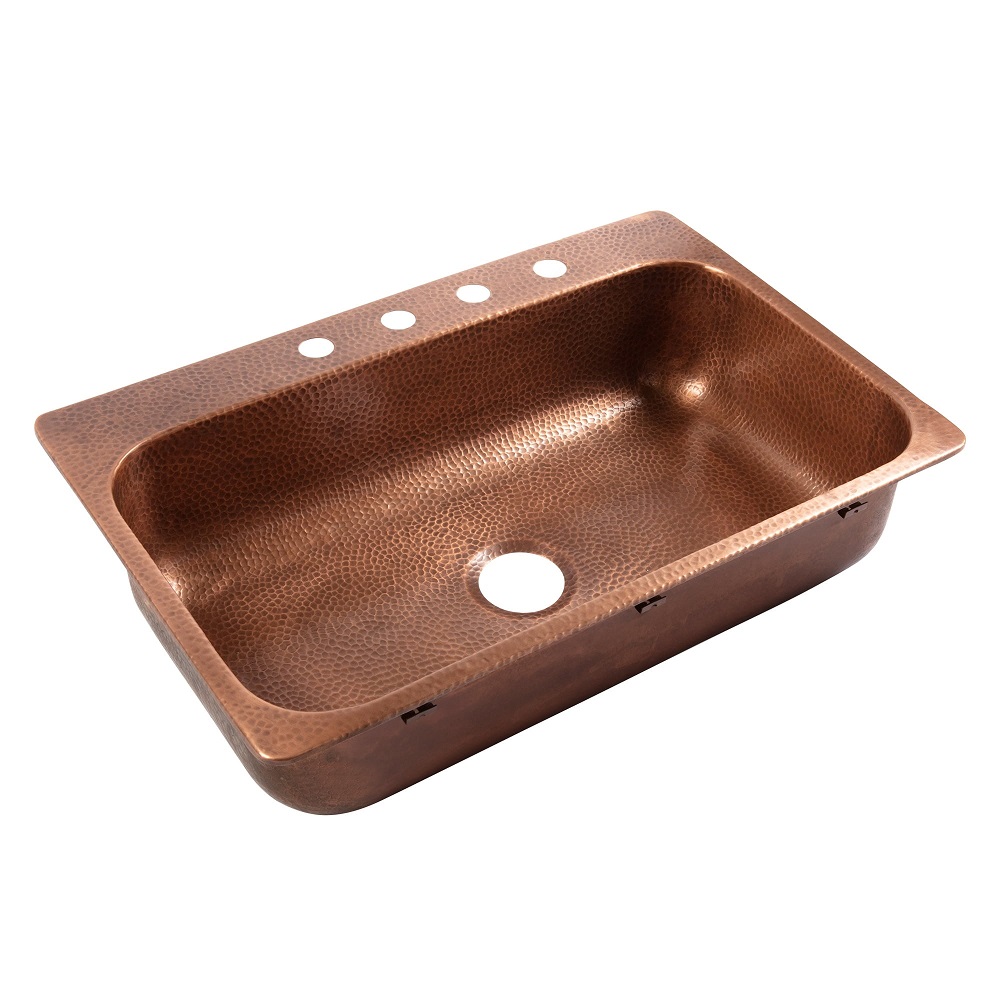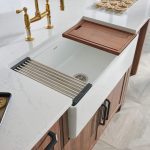When it comes to kitchen sink, there are many materials to consider. One increasingly popular option is copper. Copper kitchen sinks have gained attention in recent years for their distinctive look, durability, and antibacterial properties. However, like any material, they come with their own set of advantages and disadvantages. If you’re thinking about installing a copper sink in your kitchen, it’s essential to know both the benefits and the potential challenges before making a decision. In this article, we will explore the pros and cons of copper kitchen sinks and provide useful insights to help you make an informed choice.
What Makes Copper Kitchen Sinks Unique?
Aesthetics and Style of Copper Sinks
Copper kitchen sinks stand out in any kitchen due to their rich, warm tone and rustic charm. Over time, copper develops a beautiful patina, which can range from a deep reddish-brown to a greenish-blue color depending on how it interacts with the elements. This unique patina is one of the key features that attract homeowners looking for a sink with character. Each sink will develop its own patina, making it a one-of-a-kind addition to your kitchen.
Copper sinks also offer a sense of timelessness. The warm hues of copper can complement a wide variety of kitchen designs, from traditional to modern. Whether your kitchen features granite countertops, wooden cabinetry, or stainless steel appliances, a copper sink can add a touch of luxury and sophistication. The natural, hand-crafted appearance of copper also contributes to its appeal, as many copper sinks are made by skilled artisans, ensuring each sink is crafted with attention to detail.
The Durability of Copper in the Kitchen
Copper is an incredibly durable material, making it an excellent choice for kitchen sinks. It is naturally resistant to corrosion, meaning it won’t rust like other metals. This quality makes it ideal for high-moisture environments such as kitchens, where water is frequently splashed and spills are common. Additionally, copper is highly resistant to staining, which helps maintain its beauty over time.
One of the major benefits of copper sinks is their ability to withstand wear and tear. Copper is a malleable metal, which means it can absorb minor impacts without cracking or breaking. This is a great feature for a kitchen sink, where heavy pots and pans are often placed inside. Furthermore, copper has natural antimicrobial properties, meaning it can resist the growth of bacteria and other harmful pathogens. This is an added bonus for kitchens, where hygiene is a top priority.
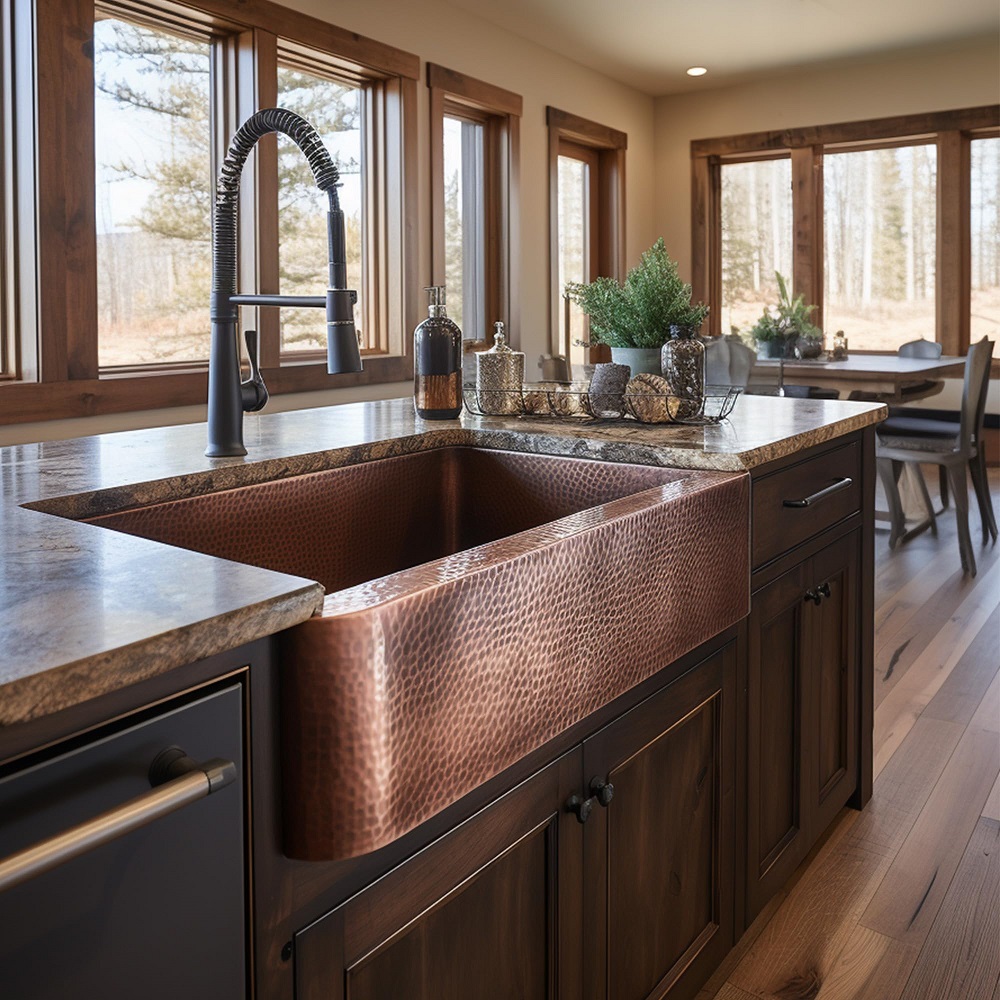
The Pros of Copper Kitchen Sinks
Aesthetic Appeal and Timeless Elegance
One of the primary reasons people opt for copper kitchen sinks is their aesthetic appeal. The warm, natural hues of copper create a striking visual effect that’s hard to match with other materials. Copper sinks bring a rustic yet elegant touch to any kitchen, making them ideal for both traditional and contemporary designs. Over time, as the copper develops a patina, the sink gains even more character, ensuring that it will always stand out.
The beauty of copper is also its versatility. Whether you have a farmhouse kitchen, a modern design, or something in between, a copper sink can easily complement your existing decor. The rich, inviting tones of the sink will make it a focal point in your kitchen, capturing the attention of anyone who enters the room. Copper sinks are available in a variety of finishes, including hammered, polished, and antique, which allows homeowners to choose a sink that best matches their style.
Durability and Resistance to Damage
Copper sinks are highly durable and can withstand the rigors of daily kitchen use. One of the standout features of copper is its resistance to corrosion. Unlike stainless steel, which can rust over time, copper resists corrosion from water and air. This means your sink will maintain its appearance and functionality for many years with proper care. Even in areas with hard water, copper sinks perform admirably, as they are less likely to develop stains or damage from mineral build-up.
In addition to corrosion resistance, copper is also highly resistant to scratches and dents. While it’s a relatively soft metal compared to others, its malleability allows it to absorb minor impacts without showing visible signs of damage. This makes copper an excellent choice for busy kitchens where pots, pans, and utensils may be dropped or knocked against the sink. A copper sink can maintain its integrity and function without looking worn or damaged.
Antimicrobial Properties for Hygiene
Copper has been shown to have natural antimicrobial properties, meaning it can help reduce the growth of harmful bacteria, viruses, and fungi. This makes it an ideal material for kitchen sinks, where cleanliness and sanitation are crucial. The copper surface actively works to kill germs and bacteria upon contact, making it easier to keep your sink free from harmful pathogens.
In kitchens where food preparation and cleaning take place, this antimicrobial quality can provide peace of mind. While regular cleaning is still necessary to maintain a sanitary environment, copper sinks can help reduce the number of bacteria present in your kitchen, making them a safer choice for families and individuals who prioritize hygiene.
The Cons of Copper Kitchen Sinks
Higher Cost Compared to Other Materials
While copper sinks offer numerous advantages, one of the main drawbacks is their cost. Copper is generally more expensive than other materials such as stainless steel, composite, or ceramic. The price of a copper sink can vary depending on factors such as size, design, and craftsmanship, but in general, you can expect to pay a premium for a high-quality copper sink.
This higher upfront cost can be a significant consideration for homeowners on a budget. Additionally, copper sinks often require specialized installation, which can further increase the overall cost of the project. However, for those who are willing to invest in a high-end sink that offers durability, style, and hygiene benefits, the cost may be justified in the long run.
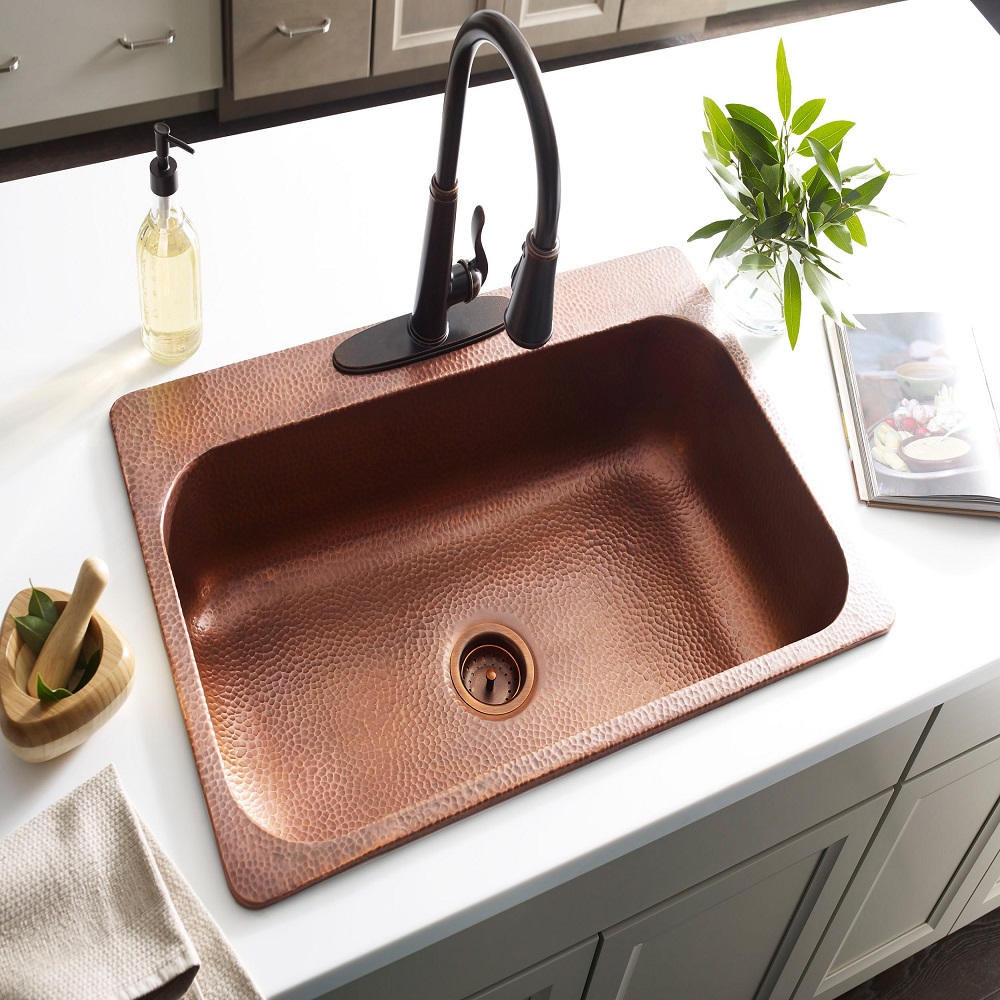
Maintenance and Care Requirements
Although copper is a durable and resilient material, it does require some maintenance to keep it looking its best. One of the main challenges with copper sinks is their tendency to develop a patina over time. While many people love the rustic look of this patina, others prefer to maintain the sink’s original shine. If you wish to preserve the bright, polished appearance of your copper sink, you will need to clean and polish it regularly to prevent tarnishing.
Additionally, copper is prone to water spots and mineral stains, particularly in areas with hard water. To prevent these stains, it’s important to dry the sink after each use and clean it with a non-abrasive cleaner. Using harsh chemicals or abrasive scrubbers can damage the copper surface, so it’s essential to use the right cleaning products to avoid causing scratches or discoloration.
Susceptibility to Damage from Harsh Chemicals
While copper is highly resistant to corrosion, it can be sensitive to certain chemicals, particularly acidic substances. Over time, exposure to harsh chemicals, such as vinegar, citrus juice, or bleach, can cause the copper to discolor or corrode. Therefore, it’s important to avoid using these substances directly on your copper sink or to rinse the sink thoroughly after contact.
Additionally, certain cleaning products, such as abrasive pads or harsh scrubbing brushes, can scratch the surface of the copper, which may lead to further damage. To protect the integrity of your copper sink, it’s advisable to use only soft cloths or sponges for cleaning and to choose non-abrasive cleaning agents designed specifically for copper surfaces.
How to Care for Your Copper Kitchen Sink
Regular Cleaning and Maintenance Tips
To maintain the beauty and longevity of your copper sink, regular cleaning is essential. Start by wiping the sink down with a soft cloth after each use to remove any water droplets, food debris, or soap residue. This will help prevent mineral deposits from forming and protect the sink from developing water spots.
For a deeper clean, use a gentle, non-abrasive copper cleaner to remove any built-up grime or tarnish. Avoid harsh chemicals or abrasive sponges that could damage the sink’s surface. It’s also a good idea to apply a copper cleaner and polish every few months to maintain the sink’s shine and prevent discoloration.
Protecting the Sink from Damage
While copper is a durable material, it’s important to take precautions to prevent damage. For example, you should avoid dropping heavy objects, such as pots or pans, directly into the sink, as this can cause dents or scratches. Additionally, try to limit the use of acidic cleaners, as they can accelerate the tarnishing process. Instead, opt for pH-balanced cleaning solutions that are safe for copper.
You may also want to consider applying a protective wax or sealant to your copper sink to help preserve its appearance and reduce the effects of oxidation. This can be especially useful if you prefer to maintain the shiny, polished look of your sink without the development of a patina.
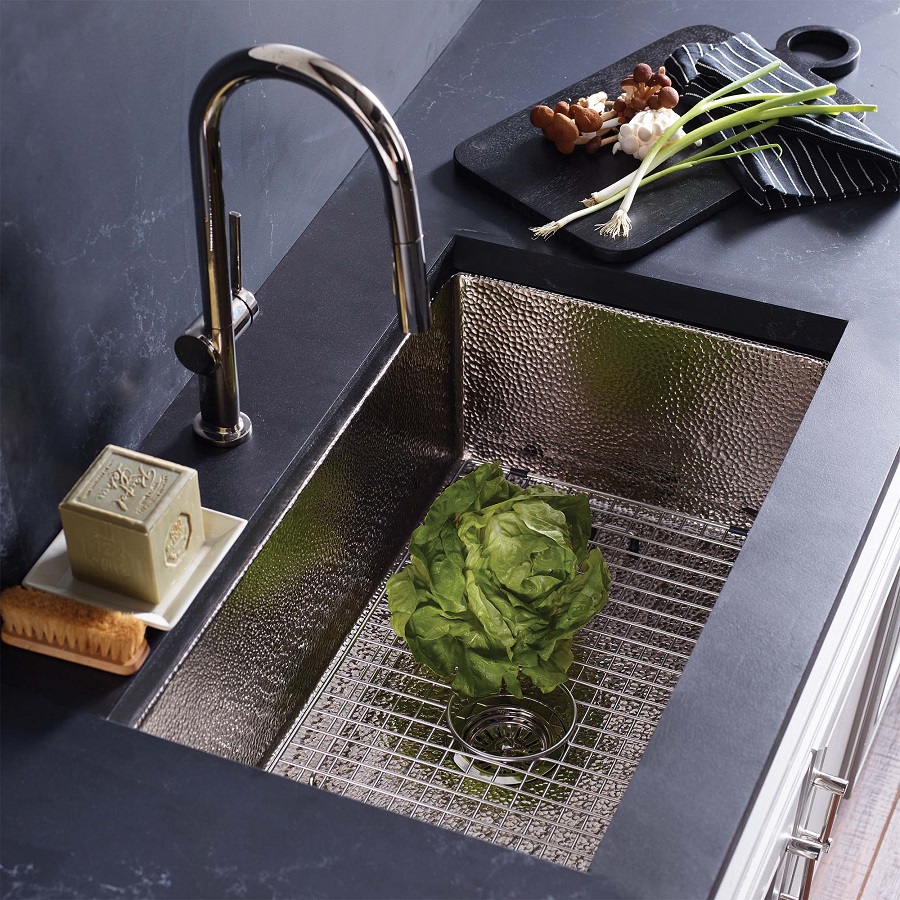
Conclusion: Is a Copper Kitchen Sink Right for You?
Weighing the Pros and Cons
Copper kitchen sinks offer numerous advantages, including their aesthetic appeal, durability, and antimicrobial properties. They can add a touch of elegance and warmth to your kitchen, making them a popular choice for homeowners who want a unique and timeless sink. However, copper sinks also come with a higher upfront cost and require more maintenance compared to other materials.
Before installing a copper sink in your kitchen, it’s important to carefully weigh the pros and cons. If you’re willing to invest in a high-quality sink and are committed to maintaining its appearance, a copper sink could be a perfect fit for your kitchen. However, if you’re looking for a low-maintenance option or are on a tight budget, you may want to consider other materials.
Ultimately, the decision to install a copper kitchen sink comes down to your personal preferences and priorities. By understanding the benefits and potential challenges of copper sinks, you can make an informed decision that best suits your needs and lifestyle.
